戴炜栋主编英语语言学教程第三章课件 Morphology
- 格式:ppt
- 大小:939.50 KB
- 文档页数:32
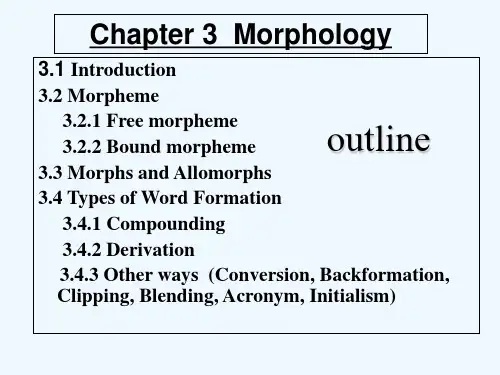

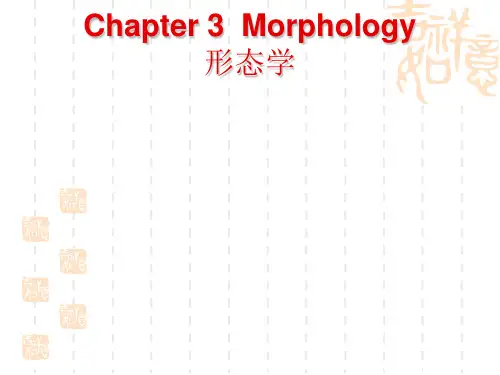
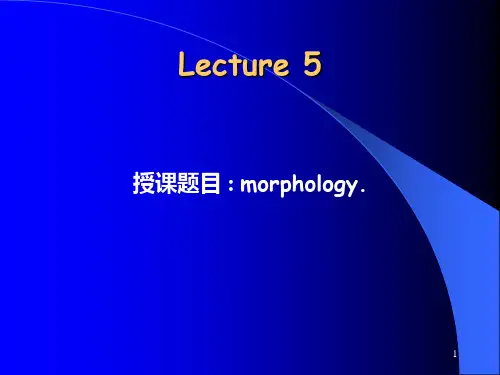
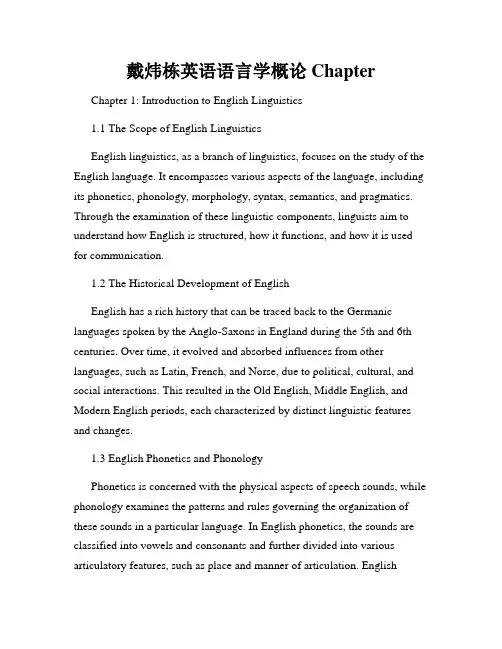
戴炜栋英语语言学概论ChapterChapter 1: Introduction to English Linguistics1.1 The Scope of English LinguisticsEnglish linguistics, as a branch of linguistics, focuses on the study of the English language. It encompasses various aspects of the language, including its phonetics, phonology, morphology, syntax, semantics, and pragmatics. Through the examination of these linguistic components, linguists aim to understand how English is structured, how it functions, and how it is used for communication.1.2 The Historical Development of EnglishEnglish has a rich history that can be traced back to the Germanic languages spoken by the Anglo-Saxons in England during the 5th and 6th centuries. Over time, it evolved and absorbed influences from other languages, such as Latin, French, and Norse, due to political, cultural, and social interactions. This resulted in the Old English, Middle English, and Modern English periods, each characterized by distinct linguistic features and changes.1.3 English Phonetics and PhonologyPhonetics is concerned with the physical aspects of speech sounds, while phonology examines the patterns and rules governing the organization of these sounds in a particular language. In English phonetics, the sounds are classified into vowels and consonants and further divided into various articulatory features, such as place and manner of articulation. Englishphonology, on the other hand, investigates sound patterns, such as stress, intonation, and phonotactics, which affect the pronunciation of words and sentences.1.4 English MorphologyMorphology is the study of word formation and structure. In English morphology, linguists analyze the internal structure of words and identify morphemes, which are the smallest meaningful units. English words can be divided into free morphemes, which can stand alone as single words, and bound morphemes, which can only be attached to other morphemes. Moreover, word formation processes, such as affixation, compounding, and derivation, are examined to understand how new words are created in English.1.5 English SyntaxSyntax investigates the rules and principles governing the arrangementof words to form grammatically correct sentences. In English syntax, linguists analyze sentence structures, constituents, and grammatical relationships, such as subject-verb agreement, word order, and sentence types (declarative, interrogative, imperative, etc.). The analysis of syntactic structures allows us to comprehend how sentences are constructed and how different meanings are conveyed through sentence formation.1.6 English SemanticsSemantics studies the meaning of linguistic expressions, including words, phrases, and sentences. In English semantics, linguists explore how meaning is conveyed through lexical and grammatical devices, such as synonyms,antonyms, hyponyms, and collocations. Additionally, pragmatic aspects, such as implicature, speech acts, and context, play a crucial role in understanding the intended meaning of utterances in different communicative situations.1.7 English PragmaticsPragmatics involves the study of how context influences the interpretation and use of language. In English pragmatics, linguists examine various pragmatic phenomena, such as politeness strategies, discourse analysis, speech acts, and conversational implicature. Understanding pragmatics helps us interpret utterances and understand the intended meanings beyond the literal level, as well as navigate the social and cultural aspects of communication.1.8 ConclusionEnglish linguistics provides us with a comprehensive understanding of the English language's structure, function, and usage. Through the examination of its phonetics, phonology, morphology, syntax, semantics, and pragmatics, linguists gain valuable insights into the complexities of English and its role as a global language. By continuing to explore and analyze these linguistic aspects, we can further enhance our knowledge and proficiency in English communication.。
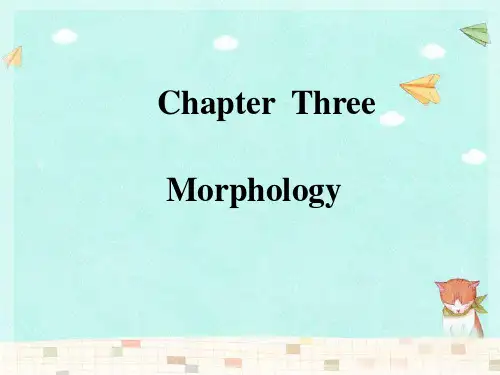
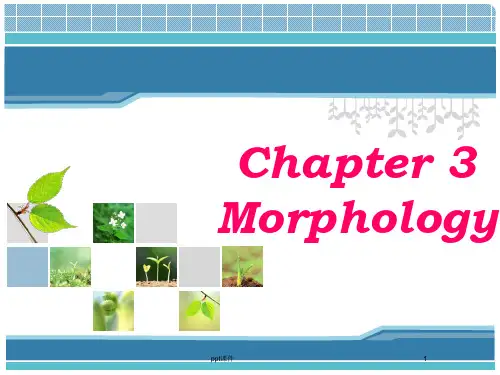
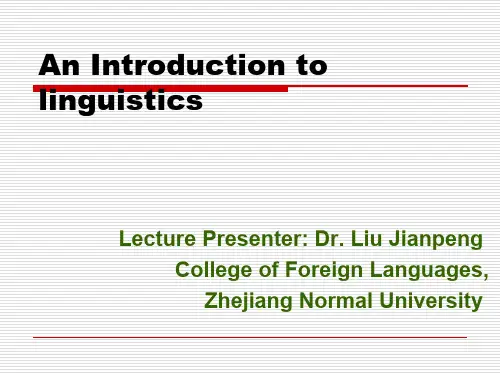


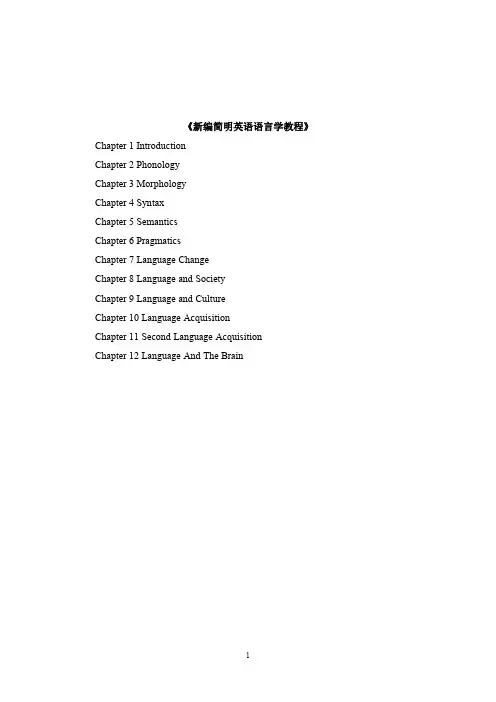
《新编简明英语语言学教程》Chapter1IntroductionChapter2PhonologyChapter3MorphologyChapter4SyntaxChapter5SemanticsChapter6PragmaticsChapter7Language ChangeChapter8Language and SocietyChapter9Language and CultureChapter10Language AcquisitionChapter11Second Language Acquisition Chapter12Language And The BrainChapter1Introduction考情分析本章分为两个部分,第一部分介绍了什么是语言学,主要是对语言学的定义、语言学的研究范围以及语言学中6对重要的概念进行了区分。
第二部分介绍了什么是语言,主要对语言的属性,语言的区别性特征以及语言的功能进行了详细的介绍。
本章常出的题型有填空题、翻译术语、术语解释、简答题以及论述题,大家在复习的时候尤其要注意以下重点内容:◆语言学中6对重要的概念区分Some important distinctions in linguistics(6)◆语言的识别性特征Design features of language(5)◆语言的功能Functions of languageContents1.1What is linguistics?1.1.1Definition1.1.2The scope of linguistics1.1.3Some important distinctions in linguistics(6)Prescriptive规定性vs.Descriptive描写性Synchronic共时性vs.Diachronic历时性Speech口语and Writing书面语Langue语言and Parole言语---Saussure索绪尔Competence语言能力and Performance语言运用---Chomsky乔姆斯基Traditional grammar传统语法and modern linguistics现代语言学1.2What is language?1.2.1Definitions1.2.2Design features of language(5)Arbitrariness任意性Productivity/Creativity创造性Duality/Double Articulation二重性Displacement移位性Cultural transmission文化传递性1.2.3Functions of languageVersion1Social function社会功能Expressive function表达功能Descriptive function描述功能Version2Code语码---Metalinguistic元语言功能Jakobson Addressee受话者---Conative意动功能Context语境---Referential所指功能Message信息----Poetic诗学功能Contact接触---Phatic communication寒暄功能Addresser说话者---Emotive情感功能Version3ideational概念功能Halliday interpersonal人际功能textual functions语篇功能Chapter1Introduction1.1What is linguistics?1.1.1DefinitionLinguistics is generally defined as the scientific study of language.◆It studies not any particular language,but it studies languages in general.◆It is a scientific study because it is based on the systematic investigation of linguisticdata,conducted with reference to some general theory of language structure.Q1.How do you interpret the following definition of linguistics:Linguistics is the scientific study of language?1.1.2The scope of linguisticsThe study of language as a whole is often called general linguistics.普通语言学Phonetics(语音学)——The study of sounds used in linguistic communication led to the establishment of phonetics.Phonology(音系学)——It studies how sounds are put together and used to convey meaning in communication.Morphology(形态学)——The study of the way in which these symbols are arranged and combined to form words has constituted the branch of study.Syntax(句法学)—It studies the rules governing the combination of words that form grammatically permissible sentences in languages.Semantics(语义学)——It studies the meaning conveyed.Pragmatics(语用学)——It studies the meaning in the context of language use.跨学科分支Sociolinguistics(社会语言学):The studies of all these social aspects of language and its relation with society.Psycholinguistics(心理语言学):The study of language to psychology.Applied linguistics(应用语言学)【2017术语解释104points】:The study of such applications is generally known as applied linguitics.In a narrow sense,it refers to the application of linguistic theories and principles to language teaching,especially the teaching of foreign andsecond languages.1.1.3Some important distinctions in linguistics(1)Prescriptive vs descriptive【2013简答题2710points】①Prescriptive(规定性)The linguistic study aims to lay down rules for“correct and standard”behavior in using language,i.e.to tell people what they should say and what they should not say.(为语言的“正确和规范”规定一系列的语法规则,例如告诉人们应该说什么和不应该说什么)【2015翻译术语18prescriptive grammar规约性语法】②Descriptive(描写性)The linguistic study aims to describe and analyze the language people actually use.(对人们使用的语言进行客观描述与分析)For example,traditional grammar is prescriptive because it aims to set models for people to follow.While modern linguistics is mostly descriptive because it is supposed to be scientific and objective and its task is to describe the language people actually use.Q2.What are the differences between the descriptive and the prescriptive approaches?(2)synchronic vs diachronic①Synchronic(共时性)——the description of a language at some point of time in history.(对某个时间点上的语言状态的描述)②Diachronic(历时性)——the description of a language as it change through time.It is a historical study;it studies the historical development of language over a period of time.【2011填空1】【2016术语解释216points】(它是对语言随着时间的变化而变化的描述,是一种历史性的研究,研究的是语言在某一段时间内的历史发展)Q4.Is modern linguistics mainly synchronic or diachronic?why?a.In modern linguistics,a synchronic approach seems to enjoy priority over a diachronic one. Because it is believed that unless the various states of a language in different historical periods are successfully studied,it would be difficult to describe the changes that have taken place in its historical development.现代语言学中,共时性研究比历时性研究更重要。
《语言学概论》学习指导第一章III. Answer the following questions briefly.1.What features does human language have, which can not be foundin animal communication system?2.Why is spoken language given priority to written language inmodern linguistics?3.What are the features of modern linguistics?第二章语音学一、导读2.1 语音研究人类交际包括两种形式:语言交际(linguistic communication) 和非语言交际(paralinguistic communication)。
非语言交际包括手势、表情、眼神或图表等。
语言交际包括口语(spoken language)和书面语(written language)。
在多数情况下,人们主要是通过口语进行交际。
口语交际的媒介是语音(speech sounds),也就是说人们通过声道(vocal track)发出的音来表达意义。
这种对语音的研究被叫做语音学(phonetics)。
口语交际是一个复杂的过程。
可以想象,当人们交际时,语音首先被说话者发出,然后,它在空气中被传递并被听话者接收。
也就是说,口语交际包括三个基本步骤:语音的发出→语音在空气中的传导→语音的接收。
根据这三个步骤, 语音研究也自然地分成三个主要研究领域。
对第一个步骤的研究是发声语音学(articulatory phonetics),研究语音的产生。
对第二个步骤的研究是声学语音学(acoustic phonetics),研究语音的物理特征。
对第三个步骤的研究是听觉语音学(auditory phonetics),研究和语音感知有关的内容。